Last Updated on October 28, 2024 by Ellen
Sargassum in the Caribbean threatens more than just your vacation. There are many ‘sargassum myths’ and there is one cruel fact: the smelly seaweed threatens the incomes of countless people who rely on tourism dollars.
And here’s another cruel fact: sargassum is now contributing to the death of coral reefs in the Caribbean.
But is the pesky plant harmful to your health? What if you swim around it or in it, or walk on the beach with some of it underfoot?
Sargassum is a seaweed that chokes shores in Caribbean vacation spots, like the Riviera Maya in Mexico, and any number of Caribbean islands. When there is too much sargassum, fish and turtles are blocked from food sources.
No one knows why the stuff has grown dramatically in recent years. Theories include agriculture runoff feeding blooms to sea temperature increases that promote growth.
In 2019, sargassum in the Caribbean was again an issue — and it spread far beyond that sea. The bloom was so large it covered nearly the width of the Atlantic Ocean. And sadly, it looks like this will be the new normal.
I have a fair amount of experience with sargassum. I was around it, or swimming with it around me, every day on the public beach in Tulum, Mexico, for several months in the second half of 2015. It smells awful when it’s rotting in the sun on land – like a valley of rotten eggs.
I’m not a biologist or oceanographer or doctor. But I did learn a few things from life experience, including ways it won’t hurt you, to ways some hotels try to keep the beaches clean for tourists.
The top five sargassum myths are all based on fears of the unknown substance that turns brilliantly blue seas to the color of old blood.
5 sargassum myths, and how to protect your vacation
- 1. ‘Green worms are all over the stuff.’
- 2. ‘Parasites in the seaweed lay eggs in your skin.’
- 3. ‘The seaweed grabs me in the water.’
- 4. ‘Sargassum on the beach will cut into your feet.’
- 5. ‘We booked an expensive hotel, so the beach will be clean.’
- *How to minimize sargassum in the Caribbean on your vacation beach
1. ‘Green worms are all over the stuff.’
People told me there were green worms wrapped up in seaweed – on land and in the water.
I closely inspected many sargassum clumps and I never saw any worms anywhere.
That’s not to say there aren’t some … somewhere. I couldn’t inspect everything. But I sure did examine quite a lot, over many months, and many tides. The seaweed is home to a ton of life I know nothing about. And sargassum can trap fish and bugs that get caught up in it. But, there definitely were no green worms ‘all over’ the stuff.
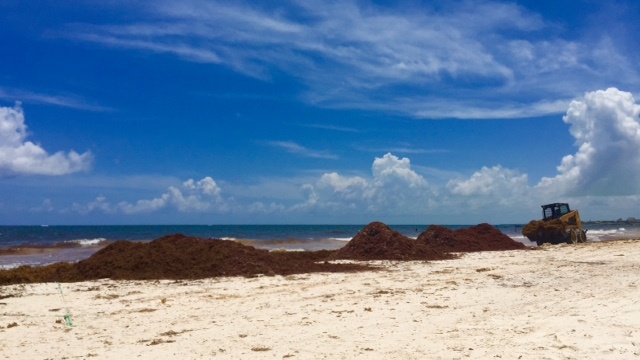
2. ‘Parasites in the seaweed lay eggs in your skin.’
If that was true, then how are people snorkeling, diving, fishing, swimming without parasitic infections? Sargassum in the Caribbean may be gross, but this myth is just super gross.
When some women in Tulum showed me their skin rashes and claimed they were the marks of something growing underneath the surface, I didn’t know how to react. That would so suck, and I’m so sorry if that’s the case! But they went in the water one time. I was in it almost every day.
A quick Google search reveals parasites can live in most kinds of seaweed. But, I couldn’t find any examples of parasites burrowing into swimmers’ skin to lay eggs. Not to say it couldn’t happen… I really don’t know. Again, I’m no scientist.
But from personal experience swimming around the unpleasant seaweed, I never had parasites or bugs burrow into my skin. I checked myself over carefully each time I got out of the water, over many swims, in many months.
Sargassum feels scratchy. Especially if it’s older and not as supple as younger plants. And it can feel creepy when you are snorkeling under a patch because it blocks sunlight. Luckily, I never had anything creepier than that with sargassum.
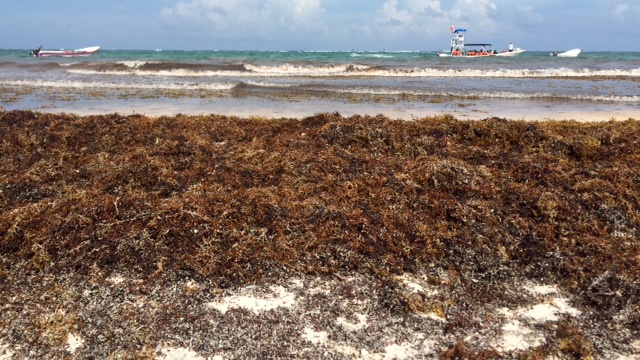
3. ‘The seaweed grabs me in the water.’
Sounds like a scary B movie.
As I mentioned, sargassum can feel a little creepy in the water, especially where there is a lot of it. The sensation ranges from relatively soft to somewhat scratchy, and it can feel like it’s creeping up your legs, down your back, etc.
The reality is that sargassum floats and moves with the water. It’s not going to eat you, like the plants that close up around bugs. It doesn’t grab you. It’s just seaweed.
4. ‘Sargassum on the beach will cut into your feet.’
Those miles of blooms of sargassum in the Caribbean are soft, but the seaweed becomes crinkly-hard, sort of approaching sharp, after it washes ashore and dries in the sun. Still, it is not sharp enough to cut through human flesh.
Sargassum does trap litter – plastic and glass and whatever trash is out there. That is what might cut you — not the actual seaweed itself.
Razor-sharp pieces of hard plastic that are broken up by the water or broken bottles, buried in the seaweed brought ashore with each tide can hurt you. A lot of trash gets stuck in the seaweed because our seas are filled with trash. But that’s another story…
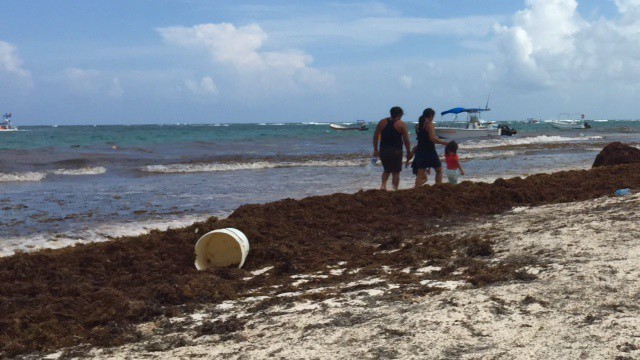
5. ‘We booked an expensive hotel, so the beach will be clean.’
Yes, the more expensive places hire extra workers to clean the beach, but no, the beach may not stay clean because the tide may or may not cooperate.
Bottom line: even if the shore is cleaned up, the stuff is still coming in from the ocean and we can’t control currents and waves.
While in Tulum, I saw hotel workers and city workers cleaning public beaches with rakes and wheelbarrows, and some heavy machinery. Usually it was pushed back further onto land, on empty lots. There it would rot and smell, as the tide brought in the next batch to be shoveled up the next day.
Incidentally, I was yelled at for taking the picture of the bulldozer below. No one wants to upset environmentalists about turtle eggs, which often are destroyed in the process of scooping sargassum off the beach with heavy machines.

*How to minimize sargassum in the Caribbean on your vacation beach
So with the top five sargassum myths covered, I want to mention a ray of hope for somewhat keeping some of this mess off your vacation beach.
A hotel north of Tulum was the first to use an experimental perimeter net to trap the sargassum and divert it away from the beach in 2015. From what I saw, it worked, somewhat, for a while. I saw it in use at the Gran Bahia Principe resort complex, about a 20 minute drive north of Tulum.
Below is a picture of the net effort in 2015. Look close near the horizon and you can see where the net stopped the sargassum – it’s the brown line between the coral reef and the boats.
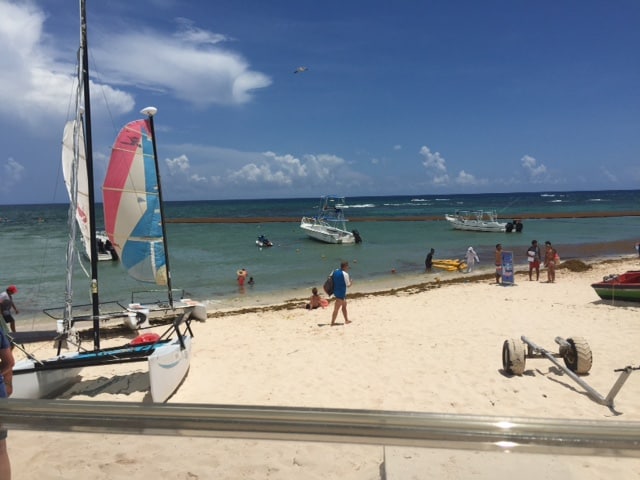
Mahahual, one of my favorite places on Earth, is set to install sargassum barriers in late 2019. And Mexico is sending boats to battle sargassum in the Caribbean. The ships are designed specifically to haul away tens of thousands of tons of the smelly, pesky seaweed.
But with blooms exploding to the size of the width of the Atlantic in 2019, these small nets, a few boats, and some barriers probably won’t change this ‘new normal.’ Still, if you are planning a vacation and don’t want to experience sargassum in the Caribbean, check to see if your hotel has deployed some kind of net barrier.
Until nature decides she’s done making such gigantic smelly seaweed blooms, we are stuck with this stuff.
Meantime, all we can do is help our Caribbean friends rake the beach.
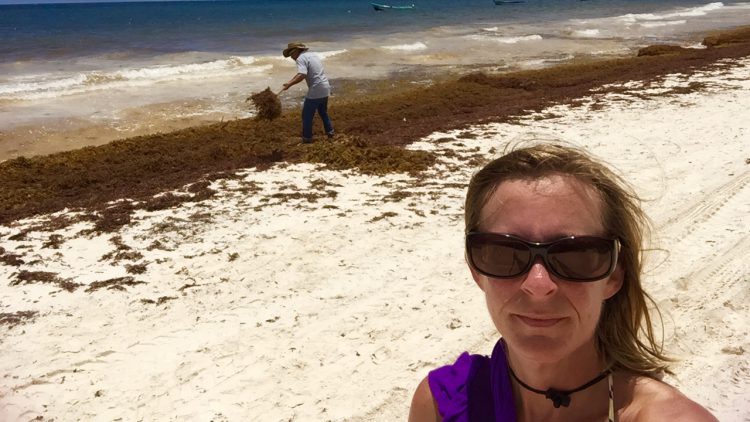
This was originally posted in September 2015. It was updated late November 2019.

